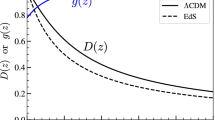Abstract
Combining the kinematical definitions of the two dimensionless parameters, the deceleration q(x) and the Hubble t 0 H(x), we get a differential equation (where x=t/t 0 is the age of the universe relative to its present value t 0). First integration gives the function H(x). The present values of the Hubble parameter H(1) [approximately t 0 H(1)≈1], and the deceleration parameter [approximately q(1)≈−0.5], determine the function H(x). A second integration gives the cosmological scale factor a(x). Differentiation of a(x) gives the speed of expansion of the universe. The evolution of the universe that results from our approach is: an initial extremely fast exponential expansion (inflation), followed by an almost linear expansion (first decelerated, and later accelerated). For the future, at approximately t≈3t 0 there is a final exponential expansion, a second inflation that produces a disaggregation of the universe to infinity. We find the necessary and sufficient conditions for this disaggregation to occur. The precise value of the final age is given only with one parameter: the present value of the deceleration parameter [q(1)≈−0.5]. This emerging picture of the history of the universe represents an important challenge, an opportunity for the immediate research on the Universe. These conclusions have been elaborated without the use of any particular cosmological model of the universe.
Similar content being viewed by others
References
Akarsu, Ö., Dereli, T.: Cosmological models with linearly varying deceleration parameter. arXiv:1102.0915, v1 [gr-qc], 4 Feb. 2011
Alfonso-Faus, A.: The case for the Universe to be a quantum black hole, arXiv:0912.1048, 2010, also in J. Astrophys. Space Sci. 325, 113–117 (2010)
Alfonso-Faus, A.: Cosmology, holography, the brain and the quantum vacuum, arXiv:1102.0443, 22 Feb. 2011 and at Plenary Lecture WSEAS Aiked 11, University of Cambridge
Caldwell, R.R.: A phantom menace? arXiv:astro-ph/9908168, v2, 15 Sep. 2002
Caldwell, R.R., Kamionkowski, M., Weinberg, N.N.: Phantom energy: dark energy with w<−1 causes a cosmic doomsday. Phys. Rev. Lett. 91, 071301 (2003)
Gurzadyan, V.G., Penrose, R.: More on the low variance circles in CMB sky, arXiv:1012.1486, 2011
Guth, A.H.: Inflationary universe: a possible solution to the horizon and flatness problems. Phys. Rev. D 23, 347 (1981)
Li, Z., et al.: Probing the course of cosmic expansion with a combination of observational data, arXiv:1011.2036v1 [gr-qc], 9 Nov. 2010
Li, Z., Wu, P., Yu, H.: Examining the cosmic acceleration with the latest Union2 supernova data. Phys. Lett. B 695, 1–8 (2011)
Linde, A.: A new inflationary universe scenario. Phys. Lett. B 108, 389 (1982)
McInnes, B.: The dS/CFT correspondence and the big smash. J. High Energy Phys. 0208, 029 (2002) and arXiv:hep-th/0112066, v4, 10 Aug. 2002
Pandolfi, S.: When did cosmic acceleration start? Nucl. Phys. B 194, 294–299 (2009)
Sivaram, C., Kenath, A.: Enigmatic aspects of the early universe: possibility of a “pre-big bang phase”. Astrophys. Space Sci. 333, 9–10 (2011)
Author information
Authors and Affiliations
Corresponding author
Rights and permissions
About this article
Cite this article
Alfonso-Faus, A. Evidence for a disaggregation of the universe. Astrophys Space Sci 337, 367–372 (2012). https://doi.org/10.1007/s10509-011-0806-7
Received:
Accepted:
Published:
Issue Date:
DOI: https://doi.org/10.1007/s10509-011-0806-7




